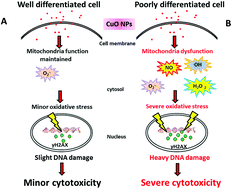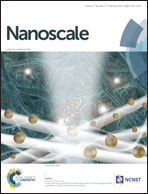Enhanced reactive oxygen species overexpression by CuO nanoparticles in poorly differentiated hepatocellular carcinoma cells†
Abstract
Copper oxide nanoparticles (CuO NPs) are known to exhibit toxic effects on a variety of cell types and organs. To determine the oxidative impact of CuO NPs on hepatocellular carcinoma (HCC) cells, well-differentiated (HepG2) and poorly differentiated (SK-Hep-1) cells were exposed to CuO NPs. Cell viability assay showed that the median inhibition concentration (IC50) for SK-Hep-1 and HepG2 cells was 25 μg ml−1 and 85 μg ml−1, respectively. Cellular fluorescence intensity using DCFH-DA staining analysis revealed significant intracellular reactive oxygen species (ROS) generation of up to 242% in SK-Hep-1 cells, compared with 86% in HepG2 cells. HPLC analysis demonstrated that a CuO NP treatment caused cellular GSH depletion of 58% and a GSH/GSSG ratio decrease to ∼0.1 in SK-Hep-1 cells. The oxidative stress caused by enhanced superoxide anion production was observed in both HepG2 (146%) and SK-Hep-1 (192%) cells. The Griess assay verified that CuO NPs induced NO production (170%) in SK-Hep-1 cells. Comet assay and western blot further demonstrated that CuO NPs induced severe DNA strand breakage (70%) in SK-Hep-1 cells and caused DNA damage via increased γ-H2AX levels. These results suggest that well-differentiated HepG2 cells possess a robust antioxidant defense system against CuO NP-induced ROS stress and exhibit more tolerance to oxidative stress. Conversely, poorly differentiated SK-Hep-1 cells exhibited a deregulated antioxidant defense system that allowed accumulation of CuO NP-induced ROS and resulted in severe cytotoxicity.


 Please wait while we load your content...
Please wait while we load your content...